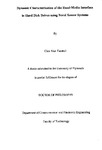Dynamic Characterisation of the Head-Media Interface in Hard Disk Drives using Novel Sensor Systems
| dc.contributor.author | Tunstall, Glen Alan | |
| dc.contributor.other | Faculty of Science and Engineering | en_US |
| dc.date.accessioned | 2013-09-10T12:35:28Z | |
| dc.date.available | 2013-09-10T12:35:28Z | |
| dc.date.issued | 2002 | |
| dc.identifier | NOT AVAILABLE | en_US |
| dc.identifier.uri | http://hdl.handle.net/10026.1/1643 | |
| dc.description.abstract |
Hard disk drives function perfectly satisfactorily when used in a stable environment, but in certain applications they are subjected to shock and vibration. During the work reported in this thesis it has been found that when typical hard disk drives are subjected lo vibration, data transfer failure is found to be significant at frequencies between 440Hz and 700Hz, at an extreme, failing at only Ig of sinusoidal vibration. These failures can largely be attributed to two key components: the suspension arm and the hard disk. At non-critical frequencies of vibration the typical hard disk drive can reliably transfer data whilst subjected to as much as 45g. When transferring data to the drive controller, the drive's operations are controlled and monitored using BIOS commands. Examining the embedded error signals proved that the drive predominantly failed due lo tracking errors. Novel piezo-electric sensors have been developed to measure unobtrusively suspension arm and disk motion, the results from which show the disk to be the most significant failure mechanism, with its First mode of resonance at around 440Hz. The suspension arm movement has been found to be greatest at IkHz. Extensive modelling of the flexure of the disk, clamped and unclamped, has been undertaken using finite element analysis. The theoretical modelling strongly reinforces the empirical results presented in this thesis. If suspension arm movement is not directly coupled with disk movement then a flying height variation is created. This, together with tracking variations, leads to data transfer corruption. This has been found to occur at IkHz and 2kHz. An optical system has been developed and characterised for a novel and inexpensive flying height measurement system using compact disc player technology. | en_US |
| dc.language.iso | en | en_US |
| dc.publisher | University of Plymouth | en_US |
| dc.title | Dynamic Characterisation of the Head-Media Interface in Hard Disk Drives using Novel Sensor Systems | en_US |
| dc.type | Thesis | |
| plymouth.version | Full version | en_US |
| dc.identifier.doi | http://dx.doi.org/10.24382/3214 |
Files in this item
This item appears in the following Collection(s)
-
01 Research Theses Main Collection
Research Theses Main


